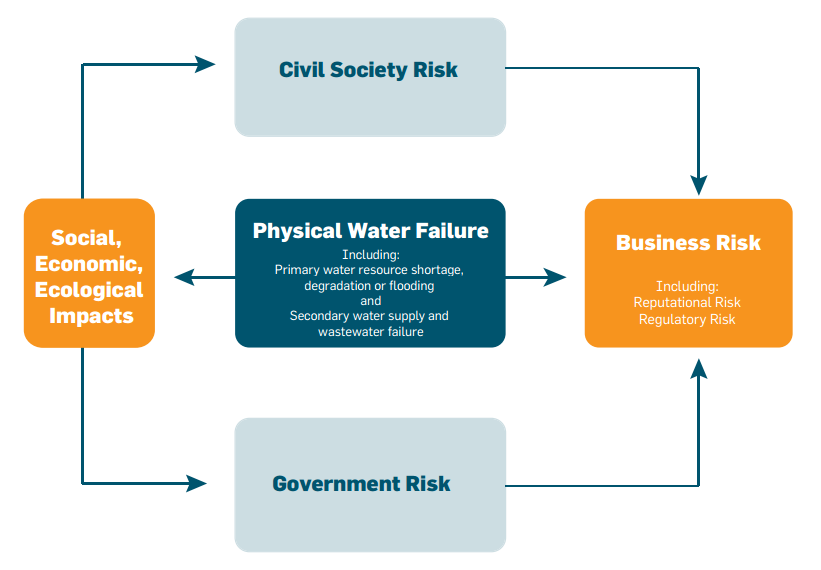Companies engage with water policy development and its implementation for many reasons. However, in many instances they are particularly motivated by the desire to reduce business risks. This section provides an overview of the source and manifestation of water-related business risk, describing the risks shared between government and business, identifying opportunities even when risks are not immediately present, and making the business case for policy engagement.
Motivations for addressing water-related business risk
The strategic decision to proactively manage water-related risks is driven by five primary inter-related motivations:
- Ensuring the company’s local legal and social license to operate in a specific location.
- Preventing or reacting to operational crises resulting from inadequate availability, supply, or quality of water or water-dependent inputs in a specific location.
- Gaining an advantage over competitors, because of stakeholder and consumer perceptions that the company uses natural resources responsibly and has minimal impacts on communities or ecosystems.
- Assuring current and potential investors and markets that business operations will continue to be profitable into the future, by securing water availability for operations and supply chains.
- Upholding corporate values and ethics based on sustainable and equitable development, by contributing to the well-being of the catchments, ecosystems, and communities in which they operate.
Water risk manifests in many different ways and for many different reasons. Understanding the cause or source of risks can be an important step in identifying the most effective way to address that risk. Companies face different water-related risks depending on the nature of a company’s operations, such as their reliance on water, value chains, and brand profile, location of operations, customer relationships, and product necessity. However, most risks are also exacerbated—and often caused entirely—by conditions external to the company, namely the hydrologic, ecological, social, and political or institutional contexts in which companies operate.
Examples of external conditions that create water-related business risk include water scarcity, inadequate operation and management of water systems, insufficient infrastructure, ineffective or inconsistent regulatory frameworks, water pollution, competition among uses, and climate change. A detailed discussion of these problems, how they create risk, and how SWM helps mitigate those risks can be found in Appendix A.
Types of water-related business risk
Water-related business risk can be examined through some inter-related lenses:
- Physical: Physical risks stem from having too little water (scarcity); too much water (flooding); or water that is unfit for use (pollution). They can be caused by drought or long-term water scarcity, over-allocation among users, flooding, or pollution that renders water unfit for use.
- Regulatory: Regulatory risks occur because of changing, ineffective, poorly implemented, or inconsistent water policies. Stricter regulatory requirements often result from water scarcity, ensuing conflict among various users, or excessive pollution. Ineffective policy can create a less inviting or stable business environment or degraded catchment conditions because of incoherent policy design or inconsistent application and enforcement.
- Reputational: Reputational risks stem from changes in how stakeholders view companies’ real or perceived negative impacts on the quantity and quality of water resources, the health and wellbeing of workers, aquatic ecosystems, and communities. Reputational concerns lead to decreased brand value or consumer loyalty or changes in regulatory posture, and can ultimately threaten a company’s legal and social license to operate.
External catchment conditions that create risk for companies also create risk for other actors in that catchment. Indeed, communities, the environment, customers, and suppliers, as well as government are all exposed to risk because of common problems, such as water scarcity, pollution, aging infrastructure, floods, droughts, and climate change. These are often the same problems that drive the missions of many civil organizations (e.g., environmental and human rights advocates) and intergovernmental agencies (e.g., UNEP and UNDP). Figure 3 shows how risks emanate from physical water failure with subsequent effects to government, business, and society.

In the same way that common problems pose risks to businesses, society, and governments, joint efforts to reduce these risks can emerge through common understanding, strategies, and solutions. All need efficient water use, clean water bodies, and effective infrastructure, and all rely on water management to address these issues and to respond to short-term priorities and plan for long-term risk. As such, shared risk provides a strong argument for business, government, and civil society to cooperate and collaborate to promote SWM.
Beyond a focus on water-related risks, companies should recognize that water policy engagement can create opportunities in circumstances where operations are not subject to immediate, substantial, or direct water-related threats. Given the high-profile nature of water resource management challenges and the substantial global concern for clean, safe water and adequate sanitation services, there are abundant opportunities for proactive corporate support to sustainable water management. Companies could actively engage with global, national, regional, and local efforts to improve legislation for water management and pollution control, to improve water infrastructure financing, and to increase access to adequate water system services.
Substantive, transparent, and accountable actions can enhance all aspects of a company’s license to operate and foster internal corporate culture that generates highly motivated staff and attracts talented workers.

